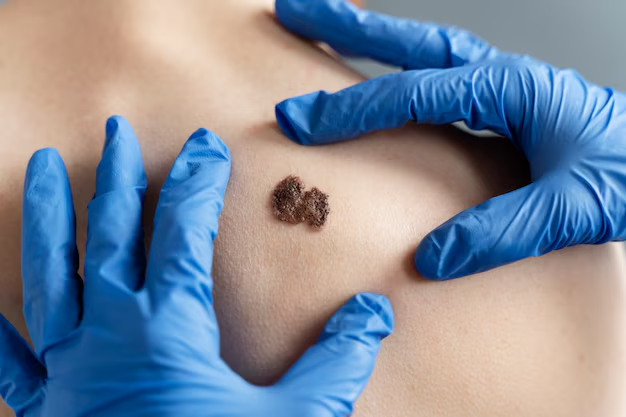What Does Skin Cancer Really Look Like? Here’s How to Spot It
In a world where sun-kissed skin is often praised, safeguarding ourselves from the adverse effects of UV exposure is crucial. Skin cancer is the most prevalent type of cancer in the United States, and while its name might sound intimidating, understanding how it presents itself on the skin can empower anyone to take swift and informed actions. But what does skin cancer really look like? Let’s explore the multifaceted appearances of skin cancer to equip you with the knowledge to recognize early warning signs.
Understanding Skin Cancer: The Basics
What Is Skin Cancer?
Skin cancer occurs when mutations develop in skin cell DNA, leading to uncontrolled cell growth. It can occur anywhere on the skin but is most frequently found on sun-exposed areas. The types of skin cancer include:
- Basal cell carcinoma: The most common type, known for its slow growth.
- Squamous cell carcinoma: Arises from the squamous cells and has a higher risk of spreading if untreated.
- Melanoma: Less common but more dangerous due to its likelihood to spread.
Why Early Detection Matters
Detecting skin cancer in its early stages significantly improves the effectiveness of treatment. By recognizing changes on your skin promptly, you can seek medical evaluation and appropriate interventions sooner rather than later.
Recognizing Skin Cancer: The Visual Clues
What Basal Cell Carcinoma Looks Like
Basal cell carcinoma (BCC) often resembles everyday skin anomalies, making it essential to pay attention to your skin’s persistent and peculiar changes. Common signs include:
- Pearly or Waxy Bumps: These bumps may appear shiny and slightly translucent.
- Flat, Flesh-Colored Lesions: Like scars, these lesions are often pink or reddish.
- Bleeding Sores: Persistent sores that bleed, scab, and then reappear.
Spotting Squamous Cell Carcinoma
Squamous cell carcinoma (SCC) is more aggressive than BCC and typically appears as:
- Rough, Scaly Patches: Commonly found on sun-exposed areas, often pink, red, or brown.
- Open Sores: That may crust or bleed.
- Raised Growths: Sometimes with a central depression.
Identifying Melanoma
Melanoma can develop anywhere on your body, not just in sun-exposed areas. It is essential to check your skin regularly, especially moles, by following the ABCDE rule:
- Asymmetry: One half of the mole doesn't match the other.
- Border: Irregular, scalloped, or poorly defined edges.
- Color: Varied shades of brown, black, or even different colors.
- Diameter: Larger than a pencil eraser (>6mm).
- Evolving: Any change in size, shape, or color.
The Importance of Self-Examinations
How to Perform a Skin Self-Exam
Regular self-examinations are crucial in identifying suspicious changes. Here’s a step-by-step guide:
- Use a Full-Length Mirror and a Hand Mirror: This will help you view all areas of your body.
- Start with Your Face and Scalp: Part your hair with a comb to check the scalp.
- Examine Your Hands and Arms: Don’t forget between fingers and underneath your arms.
- Move to Your Torso: Both front and back, using mirrors to see hard-to-reach areas.
- Check Your Legs and Feet: Look at the soles and between your toes.
What to Do If You Notice Changes
If you identify any suspicious lesions or changes, especially ones that stick around for weeks or evolve:
- Consult a Dermatologist: They can conduct a thorough examination and, if necessary, a biopsy to determine if the lesion is cancerous.
- Track Changes: Take photographs and notes to monitor any potential developments over time.
Protecting Yourself Against Skin Cancer
Sunscreen and Protective Measures
The best defense against skin cancer is protection from harmful UV rays. Here’s how to minimize risk:
- Use Broad-Spectrum Sunscreen: With at least SPF 30, apply generously and reapply every two hours.
- Wear Protective Clothing: Hats, sunglasses, and long sleeves can add an extra layer of protection.
- Seek Shade: Especially during peak sun hours (10 a.m. to 4 p.m.).
- Avoid Tanning Beds: They significantly increase the risk of skin cancer.
Lifestyle Adjustments for Skin Health
- Stay Hydrated: Well-hydrated skin is resilient against damage.
- Eat a Balanced Diet: Foods rich in antioxidants, like fruits and vegetables, can support skin health.
- Regular Dermatology Visits: If you're at higher risk, bi-annual or annual skin examinations can be helpful.
Empowering Awareness
Educating yourself and others about the signs of skin cancer not only aids in early detection but can also save lives. Sharing this information among your network increases collective vigilance, leading to better outcomes for everybody.
In conclusion, understanding what skin cancer looks like involves familiarizing yourself with its common forms and appearances. Keep a keen eye on changes in your skin and consult healthcare professionals when needed. Knowledge is your best tool against skin cancer, allowing you to take action promptly.
Quick Reference Guide: Spotting and Preventing Skin Cancer
- 👀 Regularly Examine: Perform monthly skin checks.
- 🔍 Look for ABCDE: Asymmetry, Border, Color, Diameter, Evolving.
- ☂️ Stay Protected: Use SPF, cover up, and seek shade.
- 🗓️ Routine Appointments: Schedule regular skin screenings.
- 🌿 Healthy Habits: Hydrate and consume antioxidants.
Recognize, protect, and act. Empower yourself with awareness and share the knowledge to support community well-being!

Related Articles
- Are Breast Cancer Lumps Painful
- Are Chills a Sign Of Cancer
- Are Colon Spasms a Sign Of Cancer
- Are Lytic Lesions Always Cancer
- Are Polyps Cancer
- Can a Blood Test Detect Cancer
- Can a Ct Scan Detect Cancer
- Can a Dexa Scan Show Cancer
- Can a Gastric Emptying Scan Show Cancer
- Can a Lung Biopsy Cause Cancer To Spread